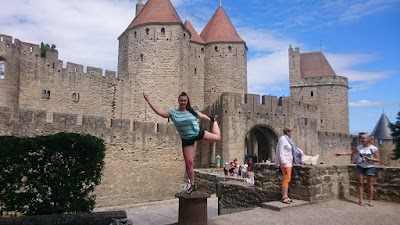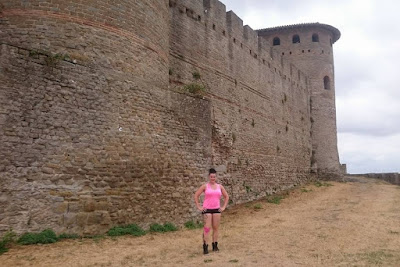Last week I travelled to France to see a fortress I wanted to see for few years now - a beautiful city Carcassonne!! Here are some yoga pics, too, I recommend to visit this amazing place at least once in a lifetime :)
If you want to know more about Carcassonne...
The earliest known occupation of the site where Carcassonne now stands dates from the 6th century BC, when a protohistoric hill-fort (oppidum) was built on this rocky spur overlooking the valley of the Aude and the ancient routes linking the Atlantic with the Mediterranean and the Iberian peninsula with the rest of Europe. Following the absorption of the region into the Roman Empire in the 1st century BC, this settlement, known as Carcaso Volcarum Tectosagum, became the Latin Colonia Iulia Carcaso in 27 BC.
During the turbulent years of the late 3rd and the early 4th century it was protected by the construction of a defensive wall some 1200m in length, the impressive remains of which still survive around two thirds of the interior fortifications of the later town. It earned the town the appellation castellum in a document dated to the 330s.
It came under Visigothic rule in the 5th century, and resisted repeated attempts by the Franks to capture it. It was a frontier town on the northern boundary of Septimania. The Arabs were more successful in 724, but were driven out in 759, after a siege led by Pépin the Short. In the 9th century it became the seat of a count, and later of a viscount.
The Visigothic period saw the creation of a bishopric at Carcassonne, sometime in the 6th century. It is probably that a cathedral was built here, on the site of the present Romanesque cathedral, on which work began in June 1096. The chancel of this structure was demolished in 1270, when construction of the new chancel started, not to be completed until the 1320s. A Lady Chapel was added in the early 15th century, adjoining the infirmary and chapel built by Bishop Radulph in the 1260s. The 12th century count's castle (chateau comtal) was built over the western part of the Roman walls; it was surrounded by a rectangular fortified enclosure in 1226. At the same time the external defensive walls were built, so as to make the town, recently annexed to the Royal domains and made the seat of a senechal, completely impregnable.
Two final construction campaigns took place in the 13th and early 14th centuries, following unsuccessful sieges in 1240 and 1280. By the end of the 13th century the town had assumed its definitive appearance as a medieval fortress. A local revolt in 1262 caused the king to expel most of the inhabitants. He allowed them to settle on the other side of the river, \\-here the new town that they set up was itself fortified in 1347.
Such was the impregnability of Carcassonne that it was never attacked during the Hundred Years' War, even during the Black Prince's raid in 1355. The Huguenots made two surprise attempts to seize the town by force in 1575 and 1585, but both were quickly repressed. It became an arsenal and supply depot during the Ancien Regime and then during the Revolution. It was removed from the list of military fortresses in 1804, then reinstated as a second-grade fortress in 1820.
As a result, it was quickly treated as a convenient stone quarry and its walls and towers began to be dismantled. The survival of this magnificent set of fortifications owes its salvation to J P Cros Mayrevieille, \\-ho succeeded on 31 July 1850 in having the decree that abandoned the defences to demolition annulled. Prosper M6rim6e, at that time Inspecteur General des Monuments Historiques, began discussions with the War Ministry to save the ramparts, and the first funds were made available for this purpose in 1852.
Eugene-Emmanuel Viollet-Ie-Duc, who had been commissioned to prepare a report as early as 1846, began his restoration work at the Porte Narbonnaise and the Porte de l' Aude, and continued working at Carcassonne until his death in 1879. During this time the internal fortifications were almost entirely restored, along with a number of the towers on the external defences.
In the last part of the century his successor Paul Boeswillwald removed the houses that had been constructed within the lists (the area between the two lines of walls) and continued working on the restoration of the walls and the castle. The restoration process was not completed until1910.



































No comments:
Post a Comment